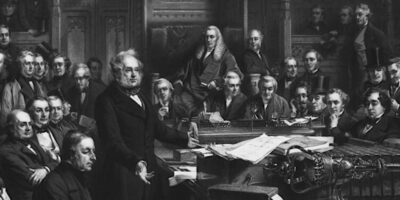Why They Try to Turn Back the Tide of History
Maybe like me, you have been mystified about the frantic imposition of tariff walls around the world over the last 18 months. It started in the US but has spread like a wildfire. Daily the barriers go up and the taxes on trade are increased. It’s hard to account for unless you want to take sole recourse in the theoretical confusions and political stamina of a US president who somehow believes that tariffs are a magic elixir that creates national economic cohesion. The growing reality, however, is that this is an international movement that is everywhere bringing back protectionism.
Something about it still doesn’t make sense. We’ve seen with our own eyes and personal experience how international economic cooperation and lower barriers to trade have broadened the division of labor and confirmed Adam Smith’s theory that this is the first condition of wealth creation. In all our own lifetimes!
Human Progress reports constantly that around the world in the last half century of growing free trade and globalization, life expectancy is up 29%, infant mortality is down 72%, medium income per person is up 167%, food supply is up 22%, and poverty has fallen more than ever recorded in human history. Concomitant with this, authoritarian governments are fewer around the world and human rights vastly more protected, which is to say, in general, governments have lost power.
This is a beautiful record. In the language of E.C. Harwood, this looks like revolution of the good sort, the overthrow of the old order of national isolation and the introduction of a new freedom and cooperation that has massively benefited humanity.
Why is there a reaction against it? Why stop what works? Why now?
Two Periods of Dramatic Change
We can get a clue at examining another case of a similar enterprise-driven revolution that occurred during the age of laissez-faire from the end of the Napoleonic Wars in 1815 to the beginning of the Great War in 1914.
During this period, the world saw similar dramatic changes in economic growth, income, infant mortality, communication technology, urbanization, and human choice generally. The end of slavery, the rise of women’s rights, the invention of the steamship and railroad, electricity, the commercialization of steel, the building of mighty cities, and flight, the rise of travel, just for starters. Government power was receding as private enterprise grew ever more powerful. The old establishment of command and control was being displaced by a new order ruled by the principles of commerce and choice.
Thus was the old order upended. But in the blink of an eye, a remarkable thing happened. There were anti-trust regulations. There was the income tax. The central bank was born. The regulatory state started policing food, medicine, labor, and law. You needed a passport to get from here to there. Even egregious ideas such as eugenics – the central planning of the population – became fashionable in the highest academic circles. There was wartime economic planning, censorship, and the regulation of financial markets.
It was the creation of the total state – that is to say, a state that knew no limits to its power. It happened over the course of one decade, from about 1908 to 1918. Again, referring to the language of Harwood, this was the counterrevolution’s answer to the revolution.
Progressivism Is Not
Now, this picture is likely to be confusing to most people with superficial historical training today. This is because for generations now, all the above changes have been characterized as Progressivism, the movement by which a benevolent elite acted for the people to protect them against private business. This myth still persists.
Actually, the deeper research shows that the real impetus of Progressivism was very different. In the words of the great historian Gabriel Kolko, this period was actually The Triumph of Conservatism. The elites of the period were in a panic about the rise of competition and commercial life and all the revolutionary changes that this implied for economy, society, culture, and the traditional powers of the ruling class.
All the controls of the period – and Kolko offers a detailed story for every big change – were designed to lock down and roll back the changes that new freedoms were bringing about. They weren’t trying to bring about Progress; they were trying to roll back history. A counterrevolution.
Of course it didn’t quite work out. Prosperity and freedom continued their march through the 20th century despite all terrible setbacks with depression and war. Their efforts proved futile but still very costly.
The Parallels
Now the parallels between then and now are becoming clear. This becomes apparent when considering the following charts. The first shows the famous hockey stick of prosperity that began soaring up in the early years of the 19th century and continued through the end of the century before reaching exponential levels later. In Europe and Asia, this is sometimes called the Great Divergence.
Here is a picture of what this meant for the world. It was truly the birth of mass wealth and prosperity. It would be naive to imagine that something on this level could happen without provoking reactionary forces, even when those forces go by the name Progressivism.
The next two charts I ran in my piece on the return of protectionism. What you see here are similar leaps in the hockey-stick formation.
We can say here exactly about our times what I said above about the movements in the early 20th century: It would be naive to imagine that something on this level could happen without provoking reactionary forces.
The globalization of commerce has empowered the common person around the world, unleashing prosperity unlike anything human history has ever seen. This has been particularly true since the collapse of communism and the reforms in China added the creative minds of many billions of people to the great project of creating wealth for all. Add to that the Internet, the free speech movement, the app economy, cryptocurrency, and the general empowerment of just about everyone, and you have all the makings of a counterrevolution.
The nation-state and all the established interests associated with it are fighting back, attempting to turn back the tide of history. It’s taking recourse to government control to stop the rise of freedom. We’ve seen this pattern before, revolution followed by counterrevolution. There are different names for the movements making this happen – right and left, socialist and nationalist, liberal and conservative – but the driving motivation is the same, namely to roll back freedom.
Knowing and seeing the pattern here makes it no less alarming but it does help reveal that these economic/political cycles are not arbitrary. And if history is our guide, we can also see that the efforts of the reactionaries against freedom will fail.












